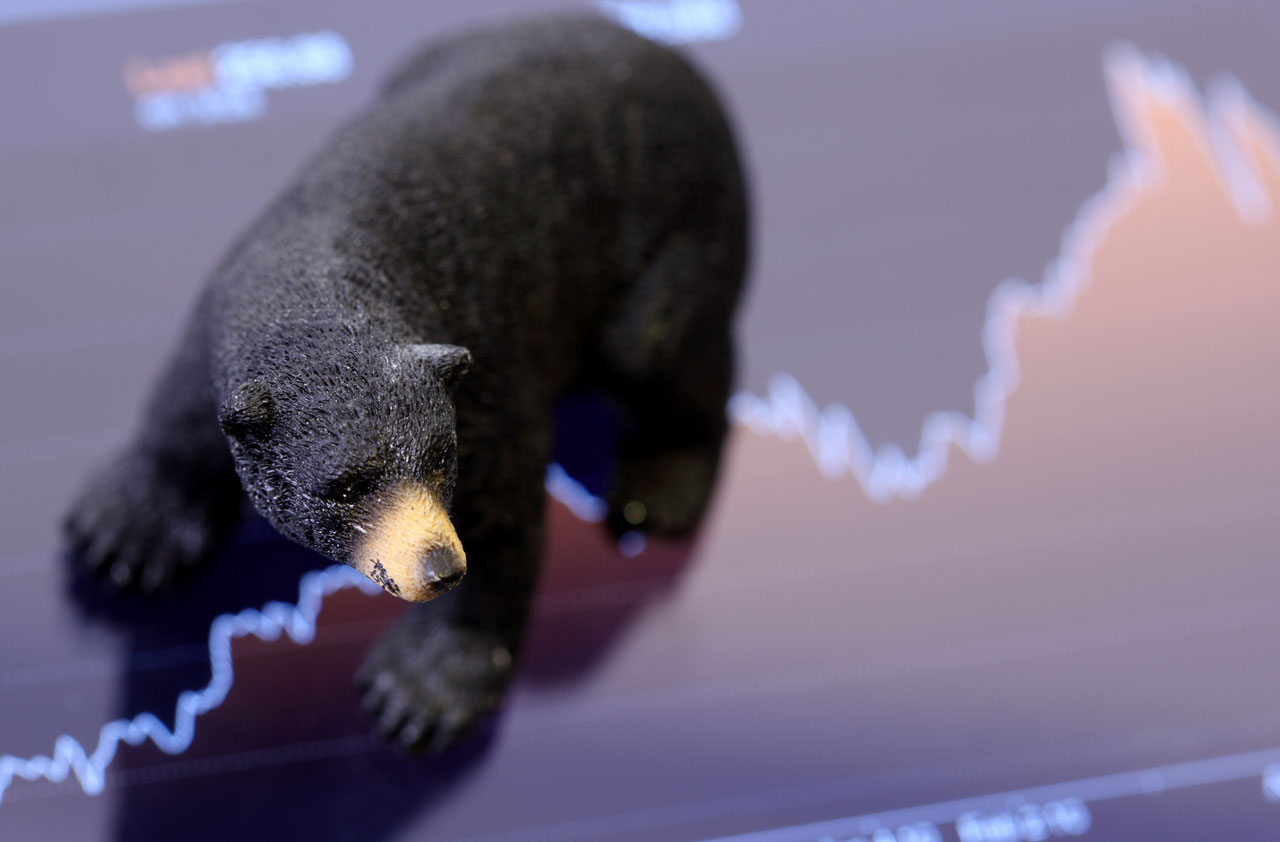5 Great Stocks for the Next Bear Market
After a long stretch of calm, market turbulence has picked up.


After a long stretch of calm, market turbulence has picked up. Standard & Poor’s 500-stock index tumbled twice in August on worries of escalating tensions with North Korea and political controversies at home. The market bounced back both times, but it remains below its recent high. And some analysts say it may not take much to knock stocks down more.
One reason for concern is simply that the market has risen steadily for months without taking a breather. On average, the S&P 500 falls 5% every 10 weeks and 10% every 33 weeks, notes economist David Rosenberg, of Canadian investment firm Gluskin Sheff. Yet more than 77 weeks have elapsed since the last correction—a reversal of at least 10% from the market’s peak. The last such downturn occurred from July 28, 2015 to February 11, 2016, when the S&P retreated 14% from its high. “The calm of late has been the type of calm that comes before the storm,” Rosenberg says.
Despite the market’s jitters, we don’t think a major selloff is looming. Corporate profit growth, a key driver of share prices, looks healthy. And stocks typically don’t slide into a bear market (a decline of 20% or more) without signs of a recession, which doesn’t look imminent. Nonetheless, some stocks should hold up better than others if the market does slump. Here are five stocks that we like for their potential to hold steady if the market stumbles and for their attractive growth potential. None look excessively priced. And they yield more than the market average of 2%, with dividends that are likely to keep rolling in, even if the market plays dead for a while.
Data is as of August 24, 2017. Click on symbol links in each slide for current share prices and more.

Crown Castle International
- Symbol: CCI
- Share price: $106.74
- Market value: $42.4 billion
- Dividend yield: 3.6%
A real estate investment trust, Crown Castle owns 40,000 cell phone towers across the U.S. Wireless carriers and other businesses rent space on such towers to connect their networks, generating stable cash flows for Crown as a landlord.
Revenues are climbing as wireless traffic expands; the firm says mobile data demand is expected to increase fourfold by 2021. Crown is also expanding its business with small-cell nodes—communication devices installed on telephone poles, street signs and the like—to expand network capacity, a big focus of wireless carriers in densely populated urban areas.
Crown recently announced a big acquisition, too. The firm plans to buy Lightower, a company that owns 32,000 miles of fiber-optic cable, mainly in metro areas in the Northeast. Crown offered $7.1 billion in cash for Lightower and plans to issue a lot more debt to fund the deal, straining its balance sheet. But the merger will bolster revenues and profits enough to help lift Crown’s dividend, despite the debt. After the deal closes, which is expected in late 2017, Crown estimates that its annual payout will increase at a rate of 7% to 8% a year, up from 6% to 7% before the merger.

Johnson & Johnson
- Symbol: JNJ
- Share price: $132.89
- Market value: $356.7 billion
- Dividend yield: 2.5%
Tylenol and baby shampoo may be Johnson & Johnson’s best-known products. But consumer goods account for just 20% of J&J’s sales, which topped $72.5 billion in the past 12 months. Prescription drugs make up nearly half of the company’s total sales. And J&J runs a large medical devices division, making everything from surgical instruments to orthopedic products, adding up to 36% of revenue.
With such a diverse lineup, J&J “stands alone as a leader across major areas of health care,” says Morningstar analyst Damien Conover. A downturn in the economy would sting, but it shouldn’t hurt sales drastically. During the Great Recession, revenues rose 4% in 2008 from the prior year, and they dipped just 2.9% in 2009 as the economy continued to falter.
J&J does face challenges. Sales of its best-selling product, arthritis drug Remicade, are falling due to competition from a similar drug recently launched, and more Remicade copycats may be on the way.
But J&J is investing heavily to develop new products that should keep overall sales inching up. The company maintains a top, triple-A credit rating, providing borrowing power for acquisitions. Analysts expect earnings to climb 7.5% in 2018, reaching $7.72 per share, compared with 2017. And investors can count on J&J’s 45-year streak of annual dividend increases to keep going strong.

Lockheed Martin
- Symbol: LMT
- Share price: $302.60
- Market value: $87.2 billion
- Dividend yield: 2.4%
If the world gets more dangerous, it will be good for Lockheed Martin, one of the largest producers of fighter jets, attack helicopters and other military gear. The firm’s backlog of awarded international and U.S. defense contracts now sits at a record $100 billion. And Lockheed says it’s seeing strong demand for its products around the world, including a tentative deal with Saudi Arabia worth $28 billion.
Positive sentiment in Washington to boost military spending could support long-term gains in defense stocks, says Bank of America Merrill Lynch. It doesn’t hurt that President Trump recently announced a big influx of troops to Afghanistan, too.
Lockheed could face setbacks, of course, especially if demand falters for its costly, high-tech F-35 fighter jets. And the potential for gains may be limited in the near term, considering the roll the stock has been on, gaining 24.1% in the past year, including dividends.
Still, against a healthy backdrop of defense spending, both in the U.S. and abroad, BofA figures the stock has room to run. The bank recently raised its 12-month price target from $305 to $335.

Southern Company
- Symbol: SO
- Share price: $48.02
- Market value: $48.0 billion
- Dividend yield: 4.8%
With nine million customers throughout the Southeast, Southern runs one of the largest gas and electricity businesses in the country. The umbrella company for several utilities and other related energy businesses, Southern derives about 80% of its earnings, before the expenses of running the parent company, from four regulated utilities, says Morningstar analyst Charles Fishman. That gives Southern a stable revenue base with a built-in profit margin, based on regulatory approvals.
Southern is expanding into natural gas delivery, following its acquisition of AGL Resources in 2016. The combined company is now the largest gas distributor in the U.S. and will help Southern diversify its revenues further, says Ryan Kelley, comanager of the Hennessy Gas Utility Fund, which owns the stock.
Investors often seek safety in utility stocks during periods of market turmoil, and Southern should be no exception. “The stock will do well as people move away from riskier parts of the market,” says Kelley. Southern’s dividend has been climbing steadily over the past decade, he adds, and has more room to rise as earnings increase.

3M
- Symbol: MMM
- Share price: $202.12
- Market value: $120.6 billion
- Dividend yield: 2.3%
Industrial conglomerate 3M makes everything from health care products to industrial equipment, electronics and more than 2,400 consumer goods under brands such as Post-it, Scotch and Thinsulate. About half the firm’s sales come from disposable products known as “consumables,” which generate steady, recurring revenues. That makes 3M’s business relatively defensive, capable of withstanding some pain in the economy. In 2009, for instance, sales dipped a modest 8.5% to $23.1 billion, compared with 2008.
Granted, investors shouldn’t expect 3M to deliver huge returns. At about $30 billion annually, sales have been flat for years. And although the company is investing to ramp up growth, analysts don’t expect revenues to increase much in the next few years.
But the stock can still be a winner. The company is targeting annual earnings growth of 8% to 11% a year, fueled by cost savings, share buybacks, acquisitions and sales of new products. 3M’s global presence may help, too. More than half of revenues and profits come from foreign markets, and as global economic growth accelerates, the firm should benefit, particularly in emerging markets.
Profit and prosper with the best of Kiplinger's advice on investing, taxes, retirement, personal finance and much more. Delivered daily. Enter your email in the box and click Sign Me Up.

-
 Stocks Close Out Strong Month With Solid Amazon Earnings: Stock Market Today
Stocks Close Out Strong Month With Solid Amazon Earnings: Stock Market TodayAmazon lifted its spending forecast as its artificial intelligence (AI) initiatives create "a massive opportunity."
-
 I Just Paid Off My Car. Can I Downgrade My Car Insurance Now?
I Just Paid Off My Car. Can I Downgrade My Car Insurance Now?You've gotten rid of that car payment. Can you save even more by downgrading your car insurance? Here's what to consider.
-
 The Most Tax-Friendly States for Investing in 2025 (Hint: There Are Two)
The Most Tax-Friendly States for Investing in 2025 (Hint: There Are Two)State Taxes Living in one of these places could lower your 2025 investment taxes — especially if you invest in real estate.
-
 The Final Countdown for Retirees with Investment Income
The Final Countdown for Retirees with Investment IncomeRetirement Tax Don’t assume Social Security withholding is enough. Some retirement income may require a quarterly estimated tax payment by the September 15 deadline.
-
 The 24 Cheapest Places To Retire in the US
The 24 Cheapest Places To Retire in the USWhen you're trying to balance a fixed income with an enjoyable retirement, cost of living is a crucial factor to consider. Is your state the best?
-
 Dividends Are in a Rut
Dividends Are in a RutDividends may be going through a rough patch, but income investors should exercise patience.
-
 Municipal Bonds Stand Firm
Municipal Bonds Stand FirmIf you have the cash to invest, municipal bonds are a worthy alternative to CDs or Treasuries – even as they stare down credit-market Armageddon.
-
 High Yields From High-Rate Lenders
High Yields From High-Rate LendersInvestors seeking out high yields can find them in high-rate lenders, non-bank lenders and a few financial REITs.
-
 Time to Consider Foreign Bonds
Time to Consider Foreign BondsIn 2023, foreign bonds deserve a place on the fringes of a total-return-oriented fixed-income portfolio.
-
 5 Stocks to Sell or Avoid Now
5 Stocks to Sell or Avoid Nowstocks to sell In a difficult market like this, weak positions can get even weaker. Wall Street analysts believe these five stocks should be near the front of your sell list.
